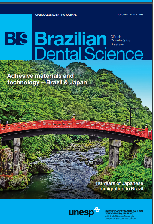Bone mineral density and mandibular osteoporotic alterations in type 2 diabetes
DOI:
https://doi.org/10.14295/bds.2018.v21i2.1587Abstract
Objective: To assess the influence of type 2 diabetes on bone mineral density in a group of type 2 diabetic patients, in comparison with non-diabetic patients. Additionally, to evaluate the correlation between mandibular cortical index and bone mineral density. Material and Methods: 48 patients (24 diabetics and 24 non-diabetics) referred for femur and spine densitometry and panoramic radiograph examination were included in this study. Patients were diagnosed based on densitometric results of the total femur and total spine. All panoramic radiomorphometric measurements were performed by 3 observers. Differences in T and Z-scores between both groups were evaluated with Mann-Whitney test and non-parametric correlations between mandibular cortical index and T/Z-scores were carried out with Spearman’s test. Results: Median T and Z-scores for total femur and total spine presented no statistical significant difference between diabetic and non-diabetic patients. In addition, only diabetics total femur and non-diabetics total spine T-scores were significantly correlated with mandibular cortical index. Conclusion: The present results suggest that type 2 diabetic patients have similar Z and T-scores in femur and spine when compared to non-diabetic patients. Mandibular cortical index, assessed on panoramic radiographs is inversely correlated with femur densitometry results in diabetics and spine bone mineral density in non-diabetic patients.
Keywords
Bone Mineral Density; Dual X-Ray Absorptiometry; Panoramic radiography; Osteoporosis; Type 2 Diabetes.
Downloads
Downloads
Published
How to Cite
Issue
Section
License
Brazilian Dental Science uses the Creative Commons (CC-BY 4.0) license, thus preserving the integrity of articles in an open access environment. The journal allows the author to retain publishing rights without restrictions.
=================




























